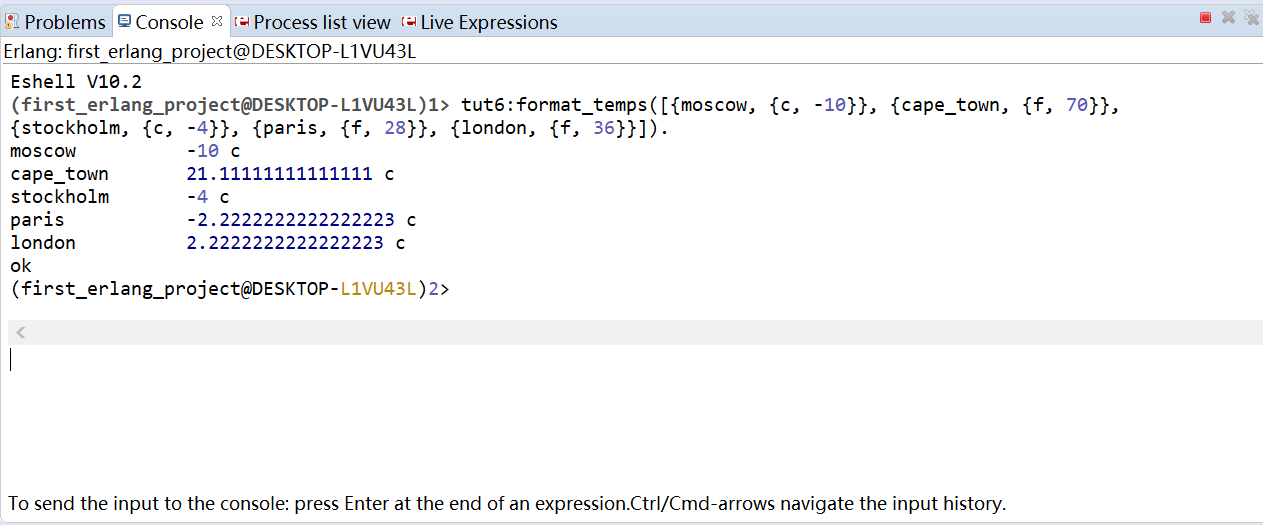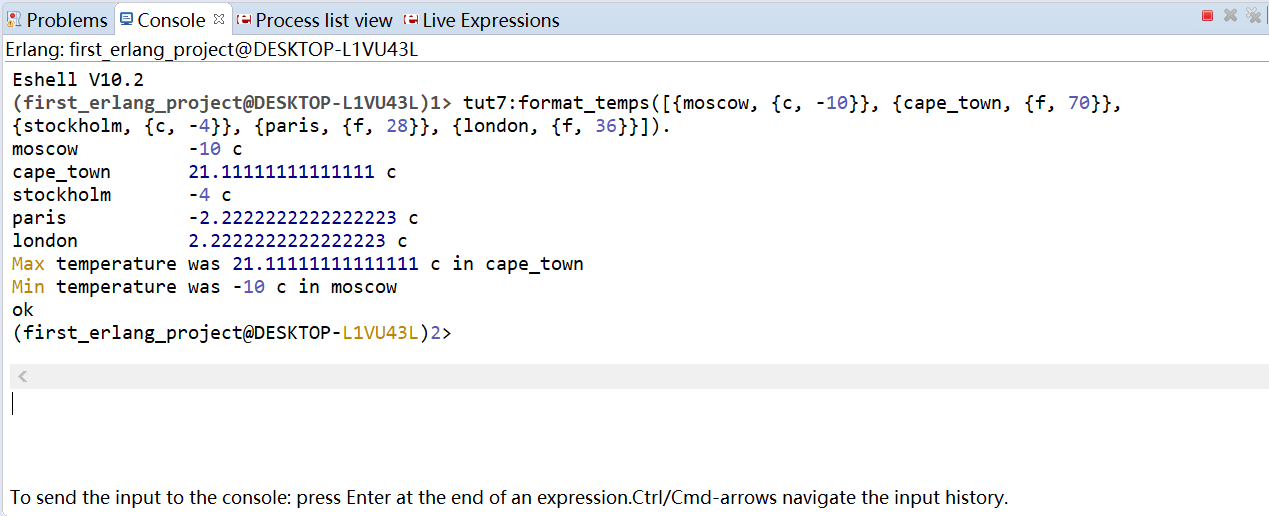Preface
This study is based on the chapter of the Guide - Sequential Programming. This chapter is dedicated to the reader’s basic knowledge of Erlang programming by writing and modifying simple examples. I quickly read and practice these examples, which gives me an intuitive understanding of how Erlang handles iterable data, such as List. And compares with Java, Python that I have learned before.
Text
Example-v1
Knowledge Points:
- io:format function:
Module io: io - Standard I/O Server Interface Functions.
The function format/2 (that is, format with two arguments) takes two lists. The first one is nearly always a list written between “ “. This list is printed out as it is, except that each ~w is replaced by a term taken in order from the second list. Each ~n is replaced by a new line. The io:format/2 function itself returns the atom ok if everything goes as planned. Like other functions in Erlang, it crashes if an error occurs. - comment:
A comment starts with a %-character and goes on to the end of the line.
- export:
The -export([format_temps/1]). line only includes the function format_temps/1. The other functions are local functions, that is, they are not visible from outside the module tut6.
- Nested:
Here is a function call as convert_to_celsius({moscow,{c,-10}}) as the argument to the function print_temp. When function calls are nested like this, they execute (evaluate) from the inside out. That is, first convert_to_celsius({moscow,{c,-10}}) is evaluated, which gives the value {moscow,{c,-10}} as the temperature is already in Celsius. Then print_temp({moscow,{c,-10}}) is evaluated.
- Recursion:
format_temps(Rest) is called with the rest of the list as an argument. This way of doing things is similar to the loop constructs in other languages.So the same format_temps function is called again, this time City gets the value {cape_town,{f,70}} and the same procedure is repeated as before. This is done until the list becomes empty, that is [], which causes the first clause format_temps([]) to match.
As my understanding by now, handling iterable data as list, Erlang uses a recursive-like approach that implements a loop traversal of the list. Later, foreach and map functions are introduced for iterable data handling.
1
2
3
4
5
6
7
8
9
10
11
12
13
14
15
16
17
-module(tut6).
-export([format_temps/1]).
%% Only this function is exported
format_temps([])-> % No output for an empty list
ok;
format_temps([City | Rest]) -> % By now, traversing list use |, and recursive call
print_temp(convert_to_celsius(City)),
format_temps(Rest).
convert_to_celsius({Name, {c, Temp}}) -> % Atom is used as matching. Variables get corresponding values in tuple.
{Name, {c, Temp}};
convert_to_celsius({Name, {f, Temp}}) -> % Do the conversion
{Name, {c, (Temp - 32) * 5 / 9}}.
print_temp({Name, {c, Temp}}) ->
io:format("~-15w ~w c~n", [Name, Temp]). % Module io
Test

Example-v2
Knowledge Points:
- if:
1 2 3 4 5 6 7 8 9 10
if Condition 1 -> Action 1; Condition 2 -> Action 2; Condition 3 -> Action 3; Condition 4 -> Action 4 endNotice that there is no “;” before end. Conditions do the same as guards, that is, tests that succeed or fail. Erlang starts at the top and tests until it finds a condition that succeeds. Then it evaluates (performs) the action following the condition and ignores all other conditions and actions before the end. If no condition matches, a run-time failure occurs. A condition that always succeeds is the atom true. This is often used last in an if, meaning, do the action following the true if all other conditions have failed.
- lists:
The module lists contains many functions for manipulating lists, for example, for reversing them. So before writing a list-manipulating function it is a good idea to check if one not already is written for you. In below example, to find the max and min value list, can use lists:max/1, lists:min/1, lists:sort/2 and so on.
1
2
3
4
5
6
7
8
9
10
11
12
13
14
15
16
17
18
19
20
21
22
23
24
25
26
27
28
29
30
31
32
33
34
35
36
37
38
39
40
41
42
43
44
45
46
47
48
49
50
51
-module(tut7).
-export([format_temps/1]).
format_temps(List_of_cities) ->
Converted_List = convert_list_to_c(List_of_cities),
print_temp(Converted_List),
{Max_city, Min_city} = find_max_and_min(Converted_List),
print_max_and_min(Max_city, Min_city).
convert_list_to_c([{Name, {f, Temp}} | Rest]) -> % Convert all temperature in list to Celsius
Converted_City = {Name, {c, (Temp -32)* 5 / 9}},
[Converted_City | convert_list_to_c(Rest)];
convert_list_to_c([City | Rest]) ->
[City | convert_list_to_c(Rest)];
convert_list_to_c([]) -> % Boundary conditions of recursive-like function
[].
print_temp([{Name, {c, Temp}} | Rest]) -> % print list of city with recursive-like function
io:format("~-15w ~w c~n", [Name, Temp]),
print_temp(Rest);
print_temp([]) -> % Boundary conditions
ok.
find_max_and_min([City | Rest]) ->
find_max_and_min(Rest, City, City).
find_max_and_min([{Name, {c, Temp}} | Rest],
{Max_Name, {c, Max_Temp}},
{Min_Name, {c, Min_Temp}}) ->
if
Temp > Max_Temp ->
Max_City = {Name, {c, Temp}}; % Change
true -> % similar as 'else' in Java, make sure all conditions have matching actions.
Max_City = {Max_Name, {c, Max_Temp}} % Unchanged
end,
if
Temp < Min_Temp ->
Min_City = {Name, {c, Temp}}; % Change
true ->
Min_City = {Min_Name, {c, Min_Temp}} % Unchanged
end,
find_max_and_min(Rest, Max_City, Min_City); % Recursive call
find_max_and_min([], Max_City, Min_City) ->
{Max_City, Min_City}.
print_max_and_min({Max_name, {c, Max_temp}}, {Min_name, {c, Min_temp}}) ->
io:format("Max temperature was ~w c in ~w~n", [Max_temp, Max_name]),
io:format("Min temperature was ~w c in ~w~n", [Min_temp, Min_name]).
Test

Example-v3
Knowledge Points:
- anonymous variable:
In sort the fun is used: fun({, {c, Temp1}}, {, {c, Temp2}}) -> Temp1 < Temp2 end . This is simply shorthand for a variable that gets a value, but the value is ignored. This can be used anywhere suitable,
- lists:
The standard module lists also contains a function sort(Fun, List) where Fun is a fun with two arguments.
This fun returns true if the first argument is less than the second argument, or else false.
Sorting is added to the convert_list_to_c . - foreach and map:
These two functions are provided in the standard module lists. foreach takes a list and applies a fun to every element in the list. map creates a new list by applying a fun to every element in a list.
1
2
3
4
5
6
7
8
9
10
11
12
13
-module(tut8).
-export([convert_list_to_c/1]).
convert_to_c({Name, {f, Temp}}) ->
{Name, {c, trunc((Temp - 32) * 5 / 9)}};
convert_to_c({Name, {c, Temp}}) ->
{Name, {c, Temp}}.
convert_list_to_c(List) ->
New_list = lists:map(fun convert_to_c/1, List),
lists:sort(fun({_, {c, Temp1}}, {_, {c, Temp2}}) ->
Temp1 < Temp2 end, New_list).
Test

Summary
From these simple examples, I practise some data type and modules of Erlang.
Next time, I will start to learn Concurrent Programming chapter following the Guides.
One of the main reasons for using Erlang instead of other functional languages is Erlang’s ability to handle concurrency and distributed programming. So next chapter will be very interesting.
Reference
http://www.erlang.org
http://erlang.org/doc/getting_started/seq_prog.html